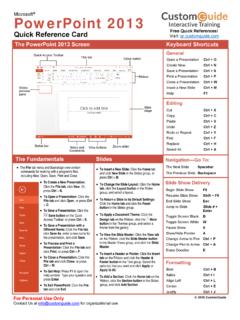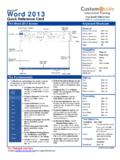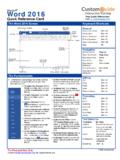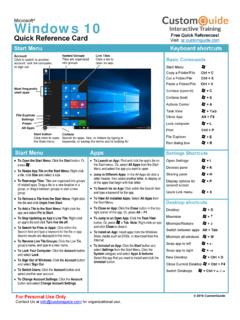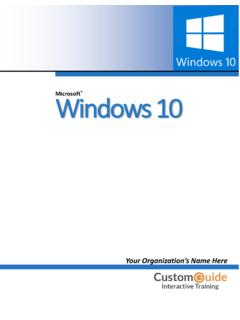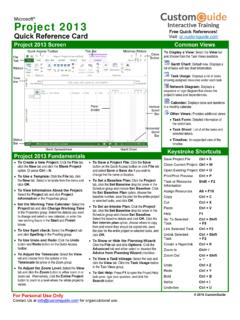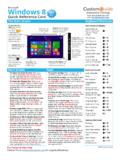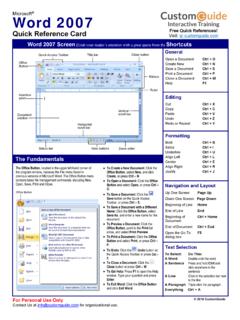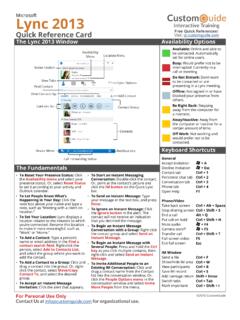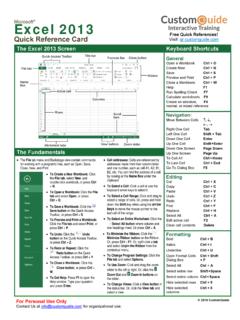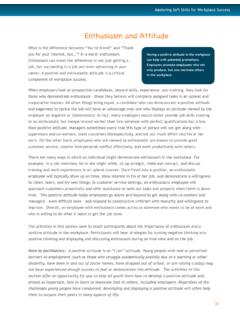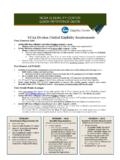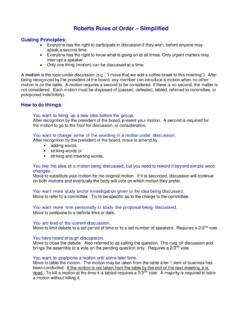Transcription of Microsoft Windows 10 - CustomGuide
1 Microsoft . Windows 10. Quick Reference Guide Free Cheat Sheets Visit Windows Desktop and Start Menu Keyboard Shortcuts General App List Tile Group App Tile Start menu .. 0 Copy a file or folder .. Ctrl + C. Cut a file or folder .. Ctrl + X. Paste a file or folder .. Ctrl + V. Action Center .. +A. Task view .. + Tab Close an app .. Alt + F4. Lock computer .. +L. Print .. Ctrl + P. Start Menu File Explorer .. +E. Account Run dialog +R. Documents Ease of Access Center.. +U. Pictures Task Manager .. Ctrl + Shift Settings Esc Power Capture screenshot .. + PrtScn Show Open Search .. +S. Desktop Open Narrator .. + Enter Start Search Task Pinned Taskbar System Button Field View Apps Icons Settings Shortcuts Windows settings .. +I. Start Menu Apps & Taskbar Connect +K. Open the Start Menu: Click the Start button on Launch an App: Click the app's tile in the Start Sharing pane.
2 +H. the taskbar, or, press the key. menu. Or, scroll through the list of apps at the left Display options for of the Start menu and select the app you want to second screen .. +P. Resize an App Tile in the Start Menu: Right-click a open. tile, select Resize, and select a size. Quick Link +X. Install an App: Click the Microsoft Store icon on Rearrange Tiles: Click and drag a tile to a new the taskbar. Browse or search for the app you Desktop Shortcuts location in a group. Or, drag a tile between groups want and click it. Click Get to install a free app or to start a new group. Buy to install a paid app. Show/hide desktop .. +D. Maximize + . Remove a Tile from the Start Menu: Right-click a Update an App: Click the Microsoft Store icon tile and select Unpin from Start. on the taskbar and click the See more button Minimize/Restore window.
3 + . at the top-right of the window. Select Downloads Minimize all Windows .. +M. Add a Tile to the Start Menu: Right-click an app and updates and click the Get updates button and select Pin to Start. at the top of the window. Snap window to + . Turn off an App's Live Tile: Right-click a tile, select Snap window to right .. + . Uninstall an App: Click the Start button and More, and select Turn Live Tile off. click the Settings button at the left of the Start View open apps .. Ctrl + Alt +. menu. Click the Apps category and select Apps Tab Rename Tile Groups: Click a tile group's name, & features at the left. Select the app you want to Switch between apps .. Alt + Tab type a new name, and click outside the name field remove and click the Uninstall button. New desktop .. + Ctrl + D. to save the changes. Hide the Taskbar: Right-click an empty space on Switch desktops.
4 + Ctrl +. Lock Your Computer: Click the Account button the taskbar, choose Taskbar settings, then / . and select Lock. toggle Automatically hide the taskbar in Close active + Ctrl + F4. Sign Out of Windows : Click the Account button desktop mode. Peek at +, and select Sign Out. Windows 10 Tablet Mode: Swipe in from the right Minimize all but the Shut Down or Restart Your PC: Click the Power side of the screen and click the Tablet Mode active window .. + Home button and select either Shut down or button. Refresh active window .. F5. Restart. 2021 CustomGuide , Inc. Click the topic links for free lessons! Contact Us: New Features Folders and Files Personalize Windows The Action Center: Gathers recent Open File Explorer: Click the File Explorer Customize System Icons: Click the Start notifications. Click the Action Center icon on the taskbar.
5 Double-click a file or folder button and click the Settings icon. Click button on the taskbar or slide your finger in to open it. Personalization and then click Taskbar at the from the right side of the screen on a left. If needed, scroll down and click Turn touchscreen device to view it. It also includes The File Explorer Ribbon: Contains options system icons on or off. Toggle a system icon some helpful quick commands: you'll need to work with your files. Click a on or off. ribbon tab ( Home, Share, View) to see related commands. Move the Taskbar: Right-click the taskbar, if Lock the taskbar has a check mark next to it, click it to unlock the taskbar. Click and drag the taskbar to the top, bottom, or side of the screen. Move or Copy Files and Folders: Select the file Customize the Lock Screen: Click the Start or folder you want to move, then click the button and click the Settings icon.
6 Click Home tab on the ribbon. Click the Move To Personalization and then click Lock screen Edge: Microsoft 's faster, more secure web or the Copy To button and select the at the left. Here, select the desired browser. While Internet Explorer is still destination folder. background, app status icons, and settings. available in Windows 10, Edge is the preferred browser. Click the Edge icon on the taskbar Rename Files and Folders: Select the file or Customize Account Settings: Click the Start to start browsing. folder you want to rename in File Explorer and button and click the Settings icon. Click click the Home tab on the ribbon. Click Accounts and then click Sign-in options at Task View: Allows you to add and switch Rename in the Organize group. Type a new the left. Modify your account settings here. between multiple desktops.
7 Click the Task name for the file or folder, then press Enter. View button on the taskbar, then click the Maintain Your Computer New Desktop button for each additional Delete Files or Folders: Select a file or folder to desktop you'd like to add. Click a desktop's delete in File Explorer. Click the Home tab on Check for Windows Updates: Click the Start thumbnail in Task view to switch to it. the ribbon and click the Delete button list button and click the Settings icon. Click arrow. Select Recycle to move it to the recycle Update & Security and then click the Check bin or Permanently Delete to completely for updates button. remove the file or folder from your computer. Open the Task Manager: Right-click the Start Search File Explorer: Click in the Search field button and select Task Manager. Or, press in the upper-right corner of the File Explorer Ctrl + Shift + Esc.
8 If an open task is no longer Tablet Mode: A mode in Windows , optimized window. Type your search term(s). Use the responding, select it here and click the End for touch, that automatically engages when a options in the Location group of the Search tab task button. touchscreen device or hybrid computer is in to change the search location. use. Manually turn Tablet mode on or off in the Improve Battery Life: Click the Battery status File Explorer Views: Click the View tab in the icon in the system tray and click Battery Action Center. File Explorer window. Use the options here to settings. Adjust the settings here to improve The Settings App: An application that includes change how your files are viewed and the battery life of your computer. a number of options to control how your organized. Windows 10 operating system behaves.
9 Click Secure Windows : Click the Security Center Compress Files or Folders: Select the files or icon in the system tray. A few options for the Start button, then click the Settings folders you want to compress and click the ensuring Windows is secure include: icon to open and modify the system settings. Share tab on the ribbon. Click the Zip Quick Access: A customizable view in File button and type a name for the compressed Virus & threat protection periodically Explorer that includes a few pinned folders, as folder, then press Enter. checks your computer for viruses and well as some other folders and files that you've other malicious files. Create a Desktop Shortcut: Right-click a file, used the most. Click the File Explorer icon Account protection provides security for folder, or program, then select Send To. on the taskbar to see the Quick Access your account and sign-in.
10 Select Desktop (Create Shortcut) in the screen. menu. Firewall & network protection Windows Ink: Used for touch screen devices configures network firewalls for private and Sort Desktop Icons: Right-click the desktop public networks to keep your computer with a stylus, Windows Ink allows you to write and select Sort by in the menu. Select a sort safe from network attacks. on your screen or create sticky notes and option. drawings. Click the Windows Ink Workspace App & browser control is where you icon on the taskbar to enable drawing with a configure warnings for suspicious files, stylus. Personalize Windows applications, and websites that you Change the Desktop Background: Click the download and visit. Start button and click the Settings icon. Device performance & health keeps Click Personalization and then use the track of system, software, and driver Windows Hello: A secure sign in feature that options in the Background category to select a updates, while monitoring storage space allows you to sign into Windows 10 using facial new background color or image.
